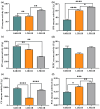Leaf functional metabolic traits reveal the adaptation strategies of larch trees along the R/B ratio gradient at the stand level
- PMID: 40451885
- PMCID: PMC12127480
- DOI: 10.1038/s41598-025-04113-1
Leaf functional metabolic traits reveal the adaptation strategies of larch trees along the R/B ratio gradient at the stand level
Abstract
Light is crucial for understory sapling regeneration, and understanding leaf functional traits (LFT) is key to saplings' adaptation to different light conditions. Currently, how LFT vary with light quality heterogeneity is not well understood. This study aims to assess canopy-induced light heterogeneity and the adaptive strategies of larch saplings to it. The study classified the light environments of larch saplings into three types based on red-to-blue light ratios: 0.6R:1B, 1.2R:1B, and 1.5R:1B. As canopy openness (CO) increases and leaf area index decreases, the proportion of red light in the understory gradually rises. Saplings under the highest CO with a 1.5R:1B had lower leaf area but higher leaf dry matter, starch, carbon, and potassium contents. Metabolite analysis revealed that, under 1.5R:1B light conditions, the upregulation of sucrose synthase (SS) and sucrose-phosphate synthase (SPS) enzyme activities accelerated the consumption of maltose in leaves, led to the accumulation of ribitol and d-glucitol, and increased the levels of organic acids, thereby promoting the accumulation of flavonoids. These findings suggest that 0.6R:1B favors a resource acquisition strategy (rapid growth), while 1.5R:1B leans towards a resource conservation strategy (slow growth). This study provides a new perspective on the effects of light conditions on understory vegetation regeneration.
Keywords: Canopy structure; Economic traits; Light quality; Metabolic traits; Natural forest; Strategy.
© 2025. The Author(s).
Conflict of interest statement
Declarations. Competing interests: The authors declare no competing interests. Conflict of interest statement: The authors declare that they have no conflicts of interest. We confirm that all experimental studies and field surveys, including those involving cultivated and wild plants, were conducted by relevant guidelines, regulations, and legislation.
Figures










Similar articles
-
Canopy position affects the relationships between leaf respiration and associated traits in a tropical rainforest in Far North Queensland.Tree Physiol. 2014 Jun;34(6):564-84. doi: 10.1093/treephys/tpu016. Epub 2014 Apr 10. Tree Physiol. 2014. PMID: 24722001
-
Investigating the European beech (Fagus sylvatica L.) leaf characteristics along the vertical canopy profile: leaf structure, photosynthetic capacity, light energy dissipation and photoprotection mechanisms.Tree Physiol. 2016 Sep;36(9):1060-76. doi: 10.1093/treephys/tpw038. Epub 2016 May 22. Tree Physiol. 2016. PMID: 27217526
-
Functional correlates of leaf demographic response to gap release in saplings of a shade-tolerant tree, Elateriospermum tapos.Oecologia. 2003 Oct;137(2):181-7. doi: 10.1007/s00442-003-1335-z. Epub 2003 Jul 15. Oecologia. 2003. PMID: 12883987
-
Elements of a dynamic systems model of canopy photosynthesis.Curr Opin Plant Biol. 2012 Jun;15(3):237-44. doi: 10.1016/j.pbi.2012.01.010. Epub 2012 Feb 9. Curr Opin Plant Biol. 2012. PMID: 22325454 Review.
-
A worldwide analysis of within-canopy variations in leaf structural, chemical and physiological traits across plant functional types.New Phytol. 2015 Feb;205(3):973-993. doi: 10.1111/nph.13096. Epub 2014 Oct 16. New Phytol. 2015. PMID: 25318596 Free PMC article. Review.
References
-
- Gendreau-Berthiaume, B. (ed Kneeshaw, D.) Influence of gap size and position within gaps on light levels. Int. J. Forestry Res.2009 581412 10.1155/2009/581412 (2009).
-
- Zhang, T., Yan, Q. L., Wang, J. & Zhu, J. J. Restoring temperate secondary forests by promoting sprout regeneration: effects of gap size and within-gap position on the photosynthesis and growth of stump sprouts with contrasting shade tolerance. For. Ecol. Manag. 429, 267–277. 10.1016/j.foreco.2018.07.025 (2018).
-
- Hertel, C., Leuchner, M. & Menzel, A. Vertical variability of spectral ratios in a mature mixed forest stand. Agric. For. Meteorol.151, 1096–1105. 10.1016/j.agrformet.2011.03.013 (2011).
-
- Navrátil, M., Špunda, V., Marková, I. & Janouš, D. Spectral composition of photosynthetically active radiation penetrating into a Norway Spruce canopy: the opposite dynamics of the Blue/red spectral ratio during clear and overcast days. Trees21, 311–320. 10.1007/s00468-007-0124-4 (2007).
-
- Wei, H. X., Chen, X., Chen, G. S. & Zhao, H. T. Foliar nutrient and carbohydrate in Aralia elata can be modified by understory light quality in forests with different structures at Northeast China. Ann. Res.62, 125–137. 10.15287/afr.2019.1395 (2019).
MeSH terms
Grants and funding
LinkOut - more resources
Full Text Sources
Research Materials

